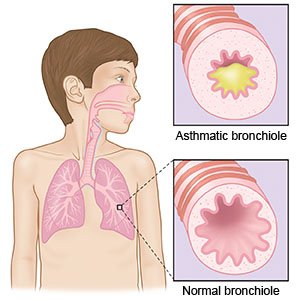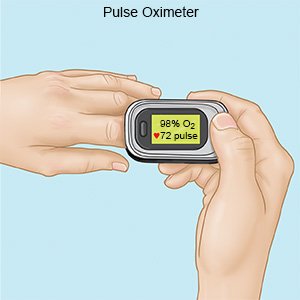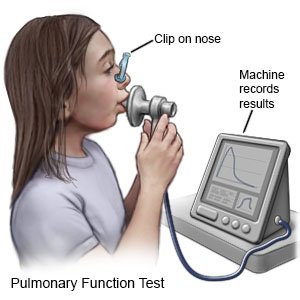Asthma in Children
Medically reviewed by Drugs.com. Last updated on Apr 6, 2025.
Asthma is a condition that causes breathing problems. Inflammation and narrowing of your child's airway prevents air from getting to his or her lungs. An asthma attack is when your child's symptoms get worse. If your child's asthma is not managed, symptoms may become chronic or life-threatening.
 |
WHILE YOU ARE HERE:
Stay with your child for comfort and support
as often as possible while he or she is in the hospital. Ask another family member or someone close to the family to stay with your child when you cannot be there. Bring items from home that will comfort your child, such as a favorite blanket or toy.
Informed consent
is a legal document that explains the tests, treatments, or procedures that your child may need. Informed consent means you understand what will be done and can make decisions about what you want. You give your permission when you sign the consent form. You can have someone sign this form for you if you are not able to sign it. You have the right to understand your child's medical care in words you know. Before you sign the consent form, understand the risks and benefits of what will be done to your child. Make sure all of your questions are answered.
Medicines:
- Bronchodilators open your child's airway to let more oxygen into his or her lungs.
- Steroids decrease inflammation and make breathing easier.
- Allergy medicine decreases allergy symptoms.
Drugs used to treat this and similar conditions
Nucala
Nucala is used to treat severe eosinophilic asthma, chronic rhinosinusitis with nasal polyps ...
Dupixent
Dupixent is used to treat eczema, eosinophilic or oral-corticosteroid-dependent asthma, chronic ...
Ozempic
Learn about Ozempic (semaglutide) for type 2 diabetes treatment, weight management, cardiovascular ...
Xolair
Xolair injection (omalizumab) is used to reduce the risk of severe food allergy reactions ...
Albuterol
Albuterol is a bronchodilator that relaxes muscles in the airways and increases air flow to the ...
Omalizumab
Omalizumab (Xolair) injection is used to reduce the risk of severe food allergy reactions ...
Dupilumab
Dupilumab (Dupixent) is used to treat eczema, eosinophilic or oral-corticosteroid-dependent asthma ...
Budesonide
Budesonide systemic is used for asthma, asthma, maintenance, autoimmune hepatitis, crohn's disease ...
Mepolizumab
Mepolizumab (Nucala) is a prescription medication FDA-approved for several eosinophil-related ...
Prednisone
Prednisone is used to treat allergic disorders, ulcerative colitis, psoriasis and arthritis. Learn ...
Monitoring:
- Your child's vital signs will be closely monitored to follow his or her heart rate, blood pressure, and breathing.
- Pulse oximetry measures how much oxygen is in your child's blood.

Tests:
- Blood tests are used to check for infection, measure oxygen levels, and give information about your child's overall health.
- Pulmonary function tests (PFTs) measure how well your child can breathe.

- A chest x-ray is used to check for other lung problems such as pneumonia.
Treatment:
- IV fluids help prevent dehydration.
- Oxygen may be given if your child's blood oxygen level is lower than it should be. Your child may get oxygen through a mask placed over his or her nose and mouth or through small tubes placed in his or her nostrils. Ask your child's pediatrician before you take off the mask or oxygen tubing.
- A ventilator is a machine that gives your child oxygen and breathes for your child when he or she cannot breathe well. An endotracheal (ET) tube is put into your child's mouth or nose and attached to the ventilator.
Treatment options
The following list of medications are related to or used in the treatment of this condition.
RISKS:
Your child may be at an increased risk for a collapsed lung, a lung infection, or other lung problems.
CARE AGREEMENT:
You have the right to help plan your child's care. Learn about your child's health condition and how it may be treated. Discuss treatment options with your child's healthcare providers to decide what care you want for your child.© Copyright Merative 2025 Information is for End User's use only and may not be sold, redistributed or otherwise used for commercial purposes.
The above information is an educational aid only. It is not intended as medical advice for individual conditions or treatments. Talk to your doctor, nurse or pharmacist before following any medical regimen to see if it is safe and effective for you.
Learn more about Asthma
Treatment options
Care guides
- Asthma
- Asthma in Children
- COPD (Chronic Obstructive Pulmonary Disease)
- Exercise-Induced Bronchoconstriction
- Moderate and Severe Persistent Asthma
- Reactive Airways Disease
Symptoms and treatments
Medicine.com guides (external)
Further information
Always consult your healthcare provider to ensure the information displayed on this page applies to your personal circumstances.
